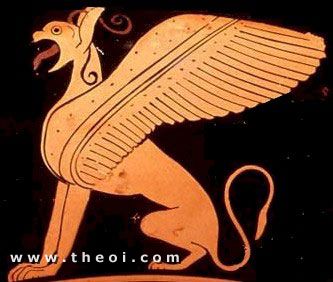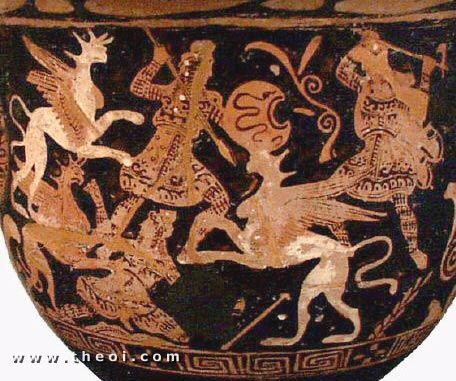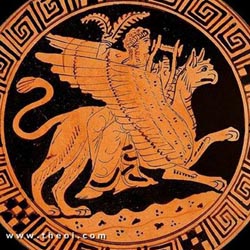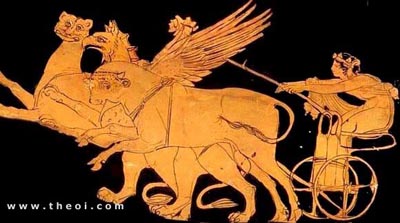

The Gryphon:Legend and Myth
© SunBlind 2007
Please do not use this text without my permission. [see footnote below]
If you find any errors or omission, please drop me a note to let me know!



 From the Greeks we get the current name of the gryphon taken from the word gryphos, which means hooked or curved, most likely refering to the creature's eagle-like beak. The gryphon appears in much Classical artwork, adorning such things as vases, mosaics, seals and coins. They also appear tombs as guardians of the dead and as bearer of the souls.
From the Greeks we get the current name of the gryphon taken from the word gryphos, which means hooked or curved, most likely refering to the creature's eagle-like beak. The gryphon appears in much Classical artwork, adorning such things as vases, mosaics, seals and coins. They also appear tombs as guardians of the dead and as bearer of the souls.
Several Ancient Greek historians, poets and playwrights have written about the gryphon over time.

Aristeas:
In 7th century B.C. Aristeas wrote his poem Arimaspia about the animosity between the Arimaspians and the gryphons. We don't have his writing, but we do have Herodotus' account of his encounter with this poet and the poem we have now lost. See the section on Herodotus next.

Herodotus:
In the 5th century B.C., Herodotus of Halicarnassus heard of the gryphon legend from Aristeas of Proconnesos. Aristeas was said to have journeyed to Northern Europe and encountered the Issedonians from whom he heard the following tale. They spoke of the Arimaspians who dwelled beyond them, a race of one-eyed humans. Beyond them lived the gold-guarding gryphons. The Arimaspians kept attempting to steal the gryphon treasures, eventually driving the gryphons away from the mountains. It is interesting to note in the text that Herodotus does not believe the stories!
The following shows a battle between the gryphons and the Arimaspians:

 The history of Herodotus — Volume 1 The history of Herodotus — Volume 1
Though I could find no reference to the following in Herodotus' text, I have seen these snippets of information attributed to him, perhaps incorrectly. Before the gryphons were driven out, the legend reported that they were guardians of hidden treasures, and the vast gold mines of India and Scythia. Thus they started out much further south. Their nests were lined with gold, and their eggs were made of agate. And they punished humans for their love of gold and treasures. In particular of course, their enemy, the Arimaspians.

Aeschylus:
Still in the 5th century B.C., Aeschylus suggested in his writings "Prometheus Bound", that gryphons actually inhabit the celestial regions of Zeus and are drawn to the realm of Pluto, the god of wealth and the underworld. Two translations are quoted here:
Now, mark my words
When I another sight of terror tell--
Beware the Gryphon pack, the hounds of Zeus,
As keen of fang as silent of their tongues!
Beware the one-eyed Arimaspian band
That tramp on horse-hoofs, dwelling by the ford
Of Pluto and the stream that flows with gold:
Keep thou aloof from these.
-----
But now listen to another and a fearsome spectacle. Beware of the sharp-beaked hounds of Zeus that do not bark, gryphons, and the one-eyed Arimaspians, mounted on horses, who dwell about the flood of Plouton's stream that flows with gold. Do not approach them.
In another scene, Oceanus, who was believed to be the world-ocean in classical antiquity, arrives mounted upon a gryphon. In Greek mythology, Oceanus is personified as a Titan, the son of Uranus and Gaia.
 Prometheus Bound Prometheus Bound
The legend of Prometheus may also have an even closer connection to gryphons. Prometheus was being punished by the gods for stealing fire from Olympus. He was bound to a mountain in Scythia, where an eagle would devour his liver every day, and every night it would grow back. Thus for all eternity he was to suffer. In some versions of the legend, it is a gryphon who devours his liver.

Ctesias:
Ctesias the Cnidian, a Greek physician and historian living in Persia in the 4th century B.C. also described the gryphon in his work, Indika.
"There is much silver in their part of the country, and the silver-mines though not deep are deeper than those in Baktria. Gold also is a product of India. It is not found in rivers and washed from the sands like the gold of the river Paktolos, but is found on those many high-towering mountains which are inhabited by the Griffons, a race of four-footed birds, about as large as wolves, having legs and claws like those of the lion, and covered all over the body with black feathers except only on the breast where they are red. On account of those birds the gold with which the mountains abound is difficult to be got."

 There were several deities associated with the gryphon. Symbolically, the gryphon is the fusion of two solar creatures, the lion and the eagle, and thus the creature was considered to be beneficient. And as sacred beasts of the sun, they also represented it's golden wealth. They drew the chariot of Apollo, the Sun God across the sky. The gryphon can also be found depicted on the lyre, Apollo's instrument. He can often also be seen mounted upon a gryphon. To him, the gryphon was sacred as it represented the Solar.
There were several deities associated with the gryphon. Symbolically, the gryphon is the fusion of two solar creatures, the lion and the eagle, and thus the creature was considered to be beneficient. And as sacred beasts of the sun, they also represented it's golden wealth. They drew the chariot of Apollo, the Sun God across the sky. The gryphon can also be found depicted on the lyre, Apollo's instrument. He can often also be seen mounted upon a gryphon. To him, the gryphon was sacred as it represented the Solar.
They were also the sacred to the goddess of justice, Nemesis, who personified divine vengeance. To her, they were sacred as they represented Retribution. As such, they had a reputation of being both watchful and vengeful. Thisis also associated with them needed to be ever vigilant to watch over their nests and treasures. A group of avenging gryphons drew her chariot. The gryphons could also be depicted with one paw on a wheel of the chariot. This is symbolic of how they help punish the proud by "rolling" them down with the chariot wheel.
To Athena, they were representative of Wisdom, while Artemis, the goddess of Wild Beasts is also the Mistress of the Gryphons (see Minoan Britomartis).
The gryphon is even connected with Dionysos, the Greek god of wine. They are seen together on coinage from Teos and Abdera. He has also been depicted on a chariot pulled by a bull, a lion, and a gryphon.



Footnote I just want to clear up when you actually need my permission to use this information. What I generally don't want is for you to simply copy this page and stick it up on your own website without asking me first, especially if you claim to have written it yourself. If you are using it for a school project, that's fine, you don't need to ask me first. Depending on your grade level, you'll know how your teacher wants you to reference the information to avoid plagirism.


|







